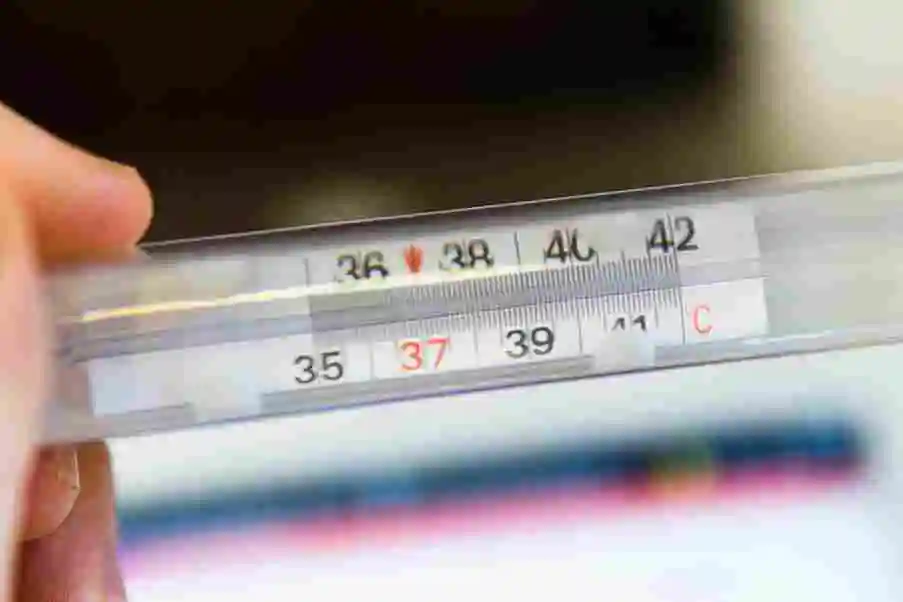What is Fever, Symptoms, Treatments, Types and Causes are often discussed on Medical Forums. Medical professionals believe that fever can be beneficial for our body because it increases the production of heat-shock proteins. However, not all fevers are created equal and there are some symptoms that should always be reported to a doctor immediately.
We’ll also delve into some practical home remedies for breaking a temperature and offer tips on preventing them in the first place. So grab your thermometer and get ready to uncover the secrets behind high temperatures. Whether you’re curious about recurrent increase in temperature or interested in understanding those peculiar dreams – we’ve got you covered!
The Normal Temperature of our Body is ( 98.6 F or 37 C) and The Conditions when our Body Temperature increase higher than normal as measured by a Thermometer in Fahrenheit or Centigrade Degrees, That Condition is Known as Fever. Although our Immunity help to fight infections, In some Cases, They can also be Uncomfortable and Trouble-Causing Depending on How High they Climb and for How much Longer it Stays and Stay Present in your Body. Today, This is the First Condition where Human Bodies experience when Affected with Covid-19 & Similar Type of Viruses in our Body. Do you know Sea Urchins?
What is Fever?
Table of Contents

This Rise in Temperature is a Symptom of infection or other illness. It can be caused by many different things, but in general it is caused by an increase in the body’s temperature to help fight infection. Symptoms usually include a high temperature, headache, and sweating. This may also cause shivering and muscle aches and pains. More severe fever symptoms may include confusion, fainting spells, and seizures. Some of the more common causes of fever include viral infections such as influenza, bacterial infections such as pneumonia, or parasitic infections that live in the body like malaria. There are also certain types of cancer that can cause fever depending on what parts of the body are affected which is often called malignant hyperthermia. Apple Cider Benefits for Weight Loss
Now, what is a fever and its sidekicks? Imagine your body cranking up the heat above the standard 98.6°F (37°C) – that’s a hike in temperature throwing a party. And boy, does it come with a guest list of symptoms! Feeling hot or getting the shivers, muscle aches, fatigue – it’s like your body RSVPed for the full experience.
But hold on, not all high temperature are cause for a panic button. In fact, they’re often your body’s way of booting out unwanted guests. However, if your body brings along some heavyweights like difficulty breathing or persistent vomiting, it might be time to call in the medical cavalry.
Our Body Fights with the Infections, Viruses & Bacterias Every time, Doesn’t Matters Whatever we Do OR Sleep. This Rise is a Condition of Increase in Body Temperature when one of the protecting mechanism of the body weakens to fight with the Infections, Viruses & Bacterias in our Body to keep your immune Strong & Away from Diseases. It is Normal Until it get overflow OR Being Ignored Carelessly.
There have been around since forever, not just a pesky temperature spike, but a superhero move by our immune system. Picture this: your body senses unwanted guests like bacteria or viruses and shouts, “Intruder alert!” Cue the release of pyrogens – chemicals that turn up the heat in your body’s control center, the hypothalamus. The result? A temperature boost that’s like rolling out the unwelcome mat for those nasty invaders, making it harder for them to hang around.
Sure, they can be a bit of a downer, but guess what? They’re often the body’s way of saying, “I got this!” Low-grade temperature rises are usually a sign that your immune warriors are on duty, no immediate medical backup needed.
But, here’s the plot twist – they can also be the sidekick to other health issues. Your body might be dropping hints alongside the high temperature – a cough, sore throat, muscle pain – little clues that help Sherlock (you!) figure out what’s going on.
Understanding this unease fest – the causes, symptoms, and the secret language your body speaks – is your ticket to managing it like a pro. So, let’s unravel the mysteries behind those temperature hikes and decode what your body is trying to tell you. Ready for the detective mission? Let’s go!
What are the Symptoms Of Fever?
The rise is temperature is a Symptom of many different conditions. It can be caused by a virus, bacteria or even the flu. If you have a shivering and it’s not connected to any of these things, it may be due to other illnesses. Some common symptoms that occur with temp include chills, achy muscles and shaking.
People having Symptoms of Fever Do feel Hot and Show Subsequent Changes in their Behavior Depending on their age. Usually People having Temperature Feel Sleepier OR Weakness in Body than usual-or both; they will refuse the breast or bottle; and they are apt to have fewer, drier diapers than normal. Older babies and toddlers become less energetic than usual. They will have no appetite but will seem especially thirsty. Finally, Patients of They can either be sleepy, weak or very irritable and have difficulty falling asleep. In this Situation, If you Consume Maximum Immunity Supplements, Natural Fruits and Try to Drink Adequate Amount of Water, May Help Naturally to Overcome the Symptoms of Rise in Temperature and Keep your Immune Secure and Strong. Exercises to Lose Belly Fat —If you note any of these changes in you, no matter how old you are, it is smart to take the temperature.
- Headache
- Sweating and shivering
- Weakness in Body
- Body Aches
- Loss of appetite & Sleepy
- Irritability
- Dehydration
- Repelling of Food
- Dinner Ideas
What are the Types of Fever?
Let’s talk about the body’s temperature symphony – a natural response that’s like a spotlight on underlying issues. So, you see, are the body’s way of saying, “Houston, we’ve got a problem!” Most of the time, it’s the usual suspects – infections gate-crashing the party. Colds, flu, or a cheeky urinary tract infection – they’re the troublemakers triggering your immune system to pull out all the stops, releasing chemicals that turn up the heat.
But wait, there’s more drama. Bacterial mischief-makers like strep throat or pneumonia? Oh, they can turn your temperature into a rollercoaster. Inflammation from tag-along conditions like rheumatoid arthritis or inflammatory bowel disease? They’re like the pyrotechnics behind the scenes, making your body feel like a fever hotspot.
Then come the viral rockstars – COVID-19 and the classic measles. They know how to make an entrance, causing temperature to steal the show. Even your everyday meds and shots can have their afterparty, sometimes leaving you with a low-grade cases as a parting gift.
Now, what is fever for the rare but serious plot twists. Autoimmune diseases, like lupus, and certain cancers? They’re the unexpected guests that can overstay their welcome, contributing to high temp that just won’t take a hint.
But here’s the clincher. Ever heard of tuberculosis, meningitis, or endocarditis? They’re the VIPs of the feveric world, less common but demanding the red carpet treatment – immediate medical attention for a proper diagnosis and eviction.
In other words, Fever is a common and severe symptom of many different diseases. It can be caused by a variety of different conditions, but usually it is due to an infection in the body. It occurs when the body attempts to fight off the infection by increasing its temperature. Symptoms include: feeling hot, sweaty, weak, having chills and red skin.
- Typhoid
- Malaria
- Rheumatic
- Dengue
- Meningitis
- Sand-fly
- Mumps
- Diphtheria
Remember, while a cause might not be the villain, it’s the superhero’s signal that something’s amiss. Don’t brush it off; team up with a healthcare sidekick if this condition persists and is playing the long game. Your body’s dropping hints – time to decode the condition Morse code!
How to Measure Body Temperature?
When it comes to checking your body temperature, no worries—we’ve got options! Let’s keep it simple and friendly. Grab a thermometer; there’s a bunch of types, like the cool digital ones and the ear-friendly ones.
For the digital crew, pop that tip under your tongue and chill for a bit. Watch the screen do its thing, but remember, no biting or chatting during this VIP moment—gotta keep it accurate!
Now, for the little munchkins, an ear thermometer is the superhero. Slide the probe gently into their ear, hit the button, and voila! Quick and accurate temperature check, just like that.
Feeling fancy? Try the temporal artery thermometer. Swipe it across your forehead, add a tad bit of pressure, and it’s game on.
Oh, heads up, different body parts, different temps. For instance, the backdoor readings might show a bit higher heat than under the tongue or armpit readings. Nature’s quirks, right?
And hey, once you’ve done the temp tango, show that thermometer some love—clean it up with rubbing alcohol or warm soapy water. A little hygiene never hurt anyone.
Knowing how to measure your temp the right way is like having a superpower. Keep an eye on any changes, and if things get a bit wonky, don’t hesitate to reach out for some pro medical help. We’ve got your back! Stay healthy, my friend.
Normally, Fever can Last from 3 to 14 Days which can be Cured with the Use of Medicines, Consuming Fruits and Vegetables, Yoga & Naturopathy. If your High Temp Persists beyond 14 Days, you have to Seek Immediate Supervision of Medicinal Practitioner or Specialized Doctor Because In such Case, your It can be, Typhoid, Malaria , Dengue OR Any Other Type of Chronic Viral. Consulting with a Doctor, will Save you from Crucial Health Problems Arising in the Future. Check out Meatloaf Recipes.
Treatment for a Fever
Breaking a the situation at home is common & possible? Easy peasy! Check out these cool remedies that’ll have you feeling better in no time.
First off, hydration is your BFF. Sip on water, herbal teas, and clear broths to keep the fluids flowing. Say goodbye to dehydration from all that sweating, and let your body find its chill.
Need a quick cool-down? Grab some cool compresses or hop into a lukewarm bath. Slap ’em on your forehead, neck, armpits, and groin, and let the natural coolness work its magic. Just a heads up, lukewarm is the way to go—cold water might send shivers up your spine and jack up that internal temp.
Time to embrace your inner sloth—rest is key. Let your body do its thing, recover, and kick that symptoms to the curb. It’s like giving your immune system a power nap.
Now, let’s talk herbs. Ginger and elderflower are the MVPs here. They’ve got anti-inflammatory vibes that can tone down those fever symptoms. But hey, a quick chat with a healthcare pro before you go all herbal is always a good move.
No marathons, please! Skip the intense workouts; they’ll just crank up that body temp. Give yourself a break and let the immune-fighting process unfold.
Quick reminder: while these home hacks are awesome, they’re not a substitute for pro advice. If things get tricky or the cause is playing hard to get, call in the medical cavalry. Stay well, friends!
The situation is a very common health problem. It affects over 30 percent of people in the United States at some point in their lives. The situation is caused by a variety of things, including infections, certain drugs or other diseases. If you experience high temp, it is important to stay well hydrated.
What are the first signs of a fever?
1. Increase in Temperature Above 98.6°F Degree Fahrenheit OR 37°C Degree Celsius.
2. Weakness in Body
3. Headache
4. Loss of appetite
5. Dehydration
Is 99.7 a fever?
99.7°F is can be Considered a Acute Fever OR may be not. It Depends upon your Body whether it keep hot or cold for the most of the day. If you eat a lot of Fruits, Vegetables & Food Supplements, It will be Normal for you As you’re Already Consuming Anti-Oxidants, Vitamins, Proteins & Minerals which Already Keep your Immune Very Strong Whereas if You’re Very Choosy in Terms of Diet, Then you might need Medications. 4 Magical Steps How to Break a Fever.
The word f e v e r can mean many different things, but it is generally used to describe an abnormal rise in body temperature that can cause discomfort. There are three types: pyrexia (temperature of 38 degrees Celsius or 101 degrees Fahrenheit), hyperpyrexia (temperature of 39 degrees Celsius or 102 degrees Fahrenheit), and hypo-pyrexia (temperature of 37 degrees Celsius or 98 degrees Fahrenheit).
Prevention in Fever
We all know how a pesky f e v e r can throw a wrench into our routine. Let’s chat about some savvy moves to keep those temperature spikes at bay.
First off, let’s talk hygiene—your frontline defense. Wash those hands like it’s going out of style, especially before munching down or touching that beautiful face of yours. And if a sneeze or cough is about to make an entrance, catch it like a superhero—tissue or elbow, your call.
Let Building up that immune system is a game-changer. Load up on the good stuff—fruits, veggies, whole grains, and lean proteins. Exercise and snoozefests are also in the VIP section of immune system support. Your body will thank you.
Play the social distancing card wisely. If someone’s doing the sick dance, keep your distance and give those high-touch surfaces a disinfecting spa day. It’s like creating a fortress against potential high temp triggers.
Vaccines are the superheroes of prevention. Arm yourself against the usual suspects like influenza and pneumonia. They boost your immune game without bringing on the illness drama.
Travel plans on the horizon? Consider preventive meds, especially if you’re jet-setting to f e v e r-prone zones. Your healthcare sidekick might have just the prescription for your adventure.
But hey, let’s keep it real. While these moves are top-notch, they don’t make you invincible. Stay vigilant, notice any health hiccups, and don’t hesitate to hit up the medical squad if things get sketchy. Stay well, stay strong, and let’s show the conditions they’re not invited to our party!
When to seek medical help for a fever?
While most fevers are harmless and resolve on their own, there are certain situations where seeking medical help is necessary. Here are some instances when you should consider consulting a healthcare professional:
1. High temperature: If your temperature persists despite home remedies or if it reaches a high temperature of 103°F (39.4°C) or above, it’s essential to seek medical attention. if you’re dealing with something that feels off, like a lingering, it might be a sign of an undercover infection. Time to call in the pros for a thorough evaluation and some top-notch treatment. Don’t let the mystery infection linger—let’s tackle it head-on for a healthier you!
2. Duration to Consider: Listen up, if that situation of yours is playing the long game and overstaying its welcome for more than three days, it’s time to raise the red flag. A cause that’s camping out for too long might be dropping hints about something more serious—possibly an ongoing infection that needs the pros to step in.
Don’t play the waiting game; get that medical intervention on your radar. Your health deserves the A-team’s attention if you feel its pulling a marathon. Stay wise, stay vigilant, and let’s keep those in check with a doctor as early as possible!
3. Severe symptoms: Should you experience severe symptoms alongside your body temperature such as difficulty breathing, chest pain, severe headache, confusion, or stiffness in the neck, do not hesitate to seek immediate medical care.
4. Infants and young children: It’s crucial to monitor infants and young children closely when they have a symptoms. Seek prompt medical attention if they appear lethargic, have trouble breathing or eating properly, show signs of dehydration (dry mouth or lack of tears), or exhibit unusual behavior.
Remember that this information serves as general guidance only; always consult with a healthcare professional for personalized advice based on your specific situation.
Conclusion
Our body’s natural superheroes fighting off those pesky infections. They can show up for various reasons like infections, inflammation, medications, or just the world around us. But the key to staying on top of the game? Accurate temperature checks.
Now, most fevers are like houseguests—you can handle them with some R&R and plenty of fluids. But, and here’s the kicker, if you notice any red flags, especially in the little ones, golden agers, or those with health backstories, it’s time to dial up the doc.
Keep an eye out for the recurring fevers or the dramatic febrile seizures—they’re like your body’s Morse code, signaling something might need attention. And let’s not forget those wild fever dreams—we might not have them all figured out, but they sure add a dash of intrigue to our sick day saga.
Bottom line: tune in to what your body’s saying when a fever hits. Take care of yourself or your crew, follow the healing vibes, and let nature do its thing. Here’s to feeling better soon!





